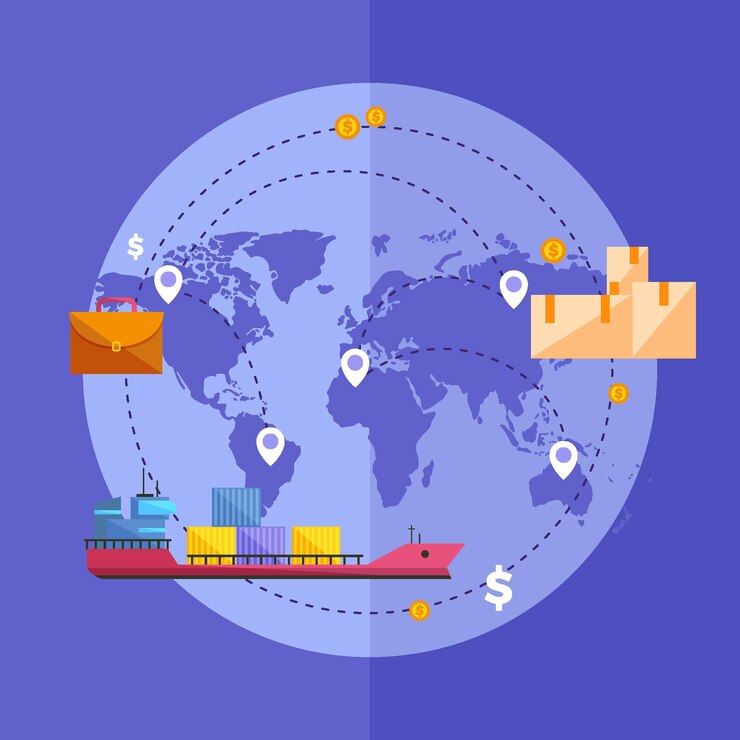What is the Third Party Export Procedure under GST?
- 9 Aug 24
- 17 mins

What is the Third Party Export Procedure under GST?
Key Takeaways
- Exports under GST are treated as zero-rated supplies, allowing exporters to operate tax-free or claim refunds.
- Exporters can claim input tax credit (ITC) on GST paid for inputs used in exported goods.
- Essential documentation includes the export invoice, shipping bill, and Letter of Undertaking (LUT) for third-party exports.
- The GST refund process for exporters is streamlined, with provisions for a provisional refund within seven days.
- Compliance with accurate documentation and timely filing is crucial to avoid delays or penalties for third-party exports under GST.
The Goods and Services Tax (GST) in India has significantly altered tax administration for both domestic and international trade. Among its many effects, one that sticks out as being particularly important for companies that export products and services is third-party export under the GST.
The following article provides a thorough overview of the ins and outs of third party export procedures under GST, making it an invaluable resource for companies navigating this complex environment.
GST and Its Impact on Exports

GST is a comprehensive indirect tax on the sale of goods and services that was implemented in India in July 2017. It has made the tax system more business-friendly and efficient by combining many levies into a single tax framework.
GST has been beneficial to exporters since it makes them zero-rated suppliers. This reduced the cost of exporting products and services significantly by enabling exporters to get refunds for input tax credits.
Simplification of the Tax Structure
Before GST, exporters had to deal with a complex tax structure involving various taxes like excise duty, service tax, and VAT, each with its own compliance requirements. Exporters now have less work to do in terms of compliance thanks to GST's introduction of a single tax system.
Due to the ease with which new exporters may now enter the market, this streamlining has improved the environment for the growth of exports.
- Unified Tax System
Value Added Tax (VAT), Service Tax, Excise Duty, and Sales Tax were just a few of the several taxes that the Central and State governments in India imposed before to the introduction of the Goods and Services Tax (GST).
This multiplicity of taxes resulted in a complex and cumbersome system with an escalating impact, Many return filing requirements and compliance requirements were all removed with the introduction of the GST, which replaced these several taxes with a single, unified tax system.
- Input Tax Credit Mechanism
The Input Tax Credit (ITC) mechanism, which enables firms to claim credit for the tax paid on inputs used in the manufacture of products or services, is a fundamental component of the products and Services Tax (GST) system.
This mechanism ensures that tax is paid only on the value added at each stage of the supply chain, thereby reducing the overall tax burden on the final product or service.
The ITC mechanism not only simplifies the tax structure but also promotes efficiency by encouraging businesses to keep a transparent record of their purchases and sales.
- Rationalization of Tax Rates
GST introduced a structured tax rate system, categorizing goods and services under different tax slabs: 0%, 5%, 12%, 18%, and 28%. This rationalization aimed to ensure that essential goods and services attract lower taxes, whereas luxury and demerit goods are taxed at a higher rate.
Such a structured approach simplifies the tax administration and ensures that the tax burden is equitably distributed, reflecting the socio-economic considerations of the population.
Enhanced Compliance and Ease of Doing Business
With GST, the entire process of tax compliance, including registration, return filing, and refund claims, has been moved online through the GST portal. The process of filing taxes has become much easier thanks to technology, which has made it faster and more efficient.
Businesses can now manage their tax obligations more effectively, contributing to an overall improvement in the ease of doing business in the country
- Zero-Rated Supplies
Under GST, exports are treated as zero-rated supplies. This means that goods or services exported are not subject to GST at the point of export. Instead, exporters can claim a refund for the input tax credit (ITC) on inputs used to produce these exported goods or services.
This part of GST has been great for exporters because it lets them get back the taxes they paid on inputs, which lowers the cost of shipping things.
- Refund Mechanism for Exporters
The GST framework has introduced a more streamlined and efficient refund mechanism for exporters. Exporters can get back the GST they paid on inputs. This has made it much easier for businesses that sell to get cash. Under the old tax system, traders had trouble getting cash because refunds were often processed late, but this system fixes that problem.
- Increased Competitiveness
By eliminating the cascading effect of taxes, where tax is levied on tax, GST has made Indian goods and services more competitive in the international market.
Indian exporters can now price their goods more cheaply because the general tax load on shipped goods has gone down. This could help them get a bigger share of global markets.
Challenges Faced by Exporters

Despite the benefits, the transition to GST has not been without challenges for exporters. Initially, there were short term issues related to the GSTN portal, delays in refund processing, and confusion over compliance requirements.
Additionally, the need to know and adapt to a new tax system posed operational challenges for many exporters, particularly smaller businesses with limited resources.
- Regulatory and Compliance Requirements
For exporters, figuring out the intricate web of regulations and compliance standards in other nations is one of the most difficult tasks. This entails being aware of and abiding by the numerous export laws, trade sanctions, and customs laws.
Compliance may be a challenging and resource-intensive procedure because to the wide variations in legal and procedural standards among nations.
- Market Access and Trade Barriers
Gaining access to new markets often involves overcoming trade barriers such as tariffs, quotas, and non-tariff barriers like stringent quality standards and labeling requirements. These obstacles may even totally prevent entrance into some markets, thus raising the cost of exporting products and services.
Exporters need to be skilled at recognizing these obstacles and devising plans of action to get beyond them, such looking for new markets or utilizing trade agreements.
- Currency Fluctuations and Financial Risks
Currency fluctuations can greatly affect the profitability of export transactions. Changes in exchange rates can unpredictably increase costs or reduce the value of receivables, posing a significant financial risk to exporters.
It can be difficult and expensive to adopt sophisticated financial instruments and methods, such forward contracts or options, to manage this risk.
- Logistics and Supply Chain Challenges
Efficiently managing logistics and supply chains is critical for successful exporting. Assuring timely delivery of goods, controlling transportation expenses, and obtaining dependable shipping routes are all included in this.
Exporters have difficulties in international shipping in addition to dealing with customs clearance and the potential for things to be lost or damaged in transit.
The COVID-19 pandemic has highlighted the vulnerability of global supply networks, since disruptions result in significant delays and increased costs.
- Payment and Credit Risks
Exporters often face the challenge of ensuring that they are paid for their goods and services. This risk is particularly pronounced in international trade, where the distance and differing legal systems can make it difficult to enforce payment obligations.
Exporters must navigate various payment terms and methods, such as letters of credit or trade credit insurance, to mitigate these risks.
- Cultural and Language Barriers
Understanding and adapting to the cultural norms and languages of target markets is essential for successful exporting.
Cultural misunderstandings can lead to miscommunications, offend potential customers, and ultimately hinder market entry.
Exporters must invest in cultural competence and, where necessary, rely on local partners or translators to bridge these gaps.
- Keeping Up with Technological Advancements
For exporters, the quick speed at which technology is developing offers both benefits and problems. Technology can, on the one hand, make it easier to enter new markets and expedite processes.
However, smaller exporters may find it difficult to remain competitive as it frequently calls for large expenditures in technology and ongoing innovation.
- Environmental Regulations and Sustainability Concerns
Increasingly, exporters must also contend with stringent environmental regulations and the growing demand for sustainable practices. In order to enter particular markets, exporting can become more complicated and expensive when environmental norms, including lowering carbon footprints and guaranteeing sustainable sourcing, are not met
What is third-party Party Exports?
Third-party exports refer to transactions where the seller (exporter) ships goods directly to a foreign buyer on behalf of the actual order placer. By using the resources of other companies, this arrangement enables enterprises to participate in export activities without having to handle the items personally.
For a business to engage in third-party exports under GST, it must meet specific criteria, such as GST registration, an active export license, and compliance with the Foreign Trade Policy. Knowing these criteria is crucial for businesses to participate in third-party exports effectively
- GST Registration
One of the primary eligibility criteria for engaging in third-party exports is the requirement for GST registration. Businesses must be registered under GST to legally carry out export transactions.
This registration makes it easy for companies to get the right forms and do the right tax things when they ship to a third party. For example, businesses can get GST returns on goods used in the export process.
- Import Export Code (IEC)
All companies engaged in the import and export of products and services are required to have an Import and Export Code (IEC). The Indian government's Directorate General of Foreign Trade (DGFT) has assigned this code as a special identifying number.
It is a prerequisite for any company looking to engage in third-party exports, serving as a key identifier in all related documentation and transactions.
- Compliance with Foreign Trade Policy
Businesses must comply with the provisions of the Foreign Trade Policy (FTP) of their respective countries. This policy explains the rules for importing and exporting, including exports from third parties.
Compliance with FTP ensures that businesses adhere to the legal requirements and standards set by the government for international trade activities.
- A valid contract or Agreement
Engaging in third-party exports typically requires a valid contract or agreement between all involved parties: the original buyer, the seller (or exporter), and the end foreign buyer.
This contract should clearly outline the terms and conditions of the sale, including delivery terms, payment conditions, and responsibilities of each party. Such documentation is crucial for legal and tax compliance.
- Bank Account in Designated Currency
To facilitate international transactions, exporters engaged in third-party exports must have a bank account capable of handling foreign exchange transactions.
This requirement is essential for receiving payments from foreign buyers in the designated currency, managing currency risks, and ensuring smooth financial transactions across borders.
- Documentation and Compliance
Proper documentation is crucial for third-party exports. This includes accurate invoicing, shipping documents, and compliance with the destination country's import regulations.
Exporters must ensure that all documents accurately represent the transaction and comply with both home country and destination country regulations to avoid delays or penalties.
- Tax Implications
Exporters must have a thorough knowledge of the tax implications of third-party exports, including the ability to navigate GST regulations, claim input tax credits, and understand the tax benefits associated with exports.
Knowledge of international tax treaties and double taxation avoidance agreements (DTAAs) is also beneficial.
- Quality and Safety Standards Compliance
Goods being exported through third-party arrangements must meet the quality and safety standards required by the destination country. Compliance with international certifications and standards (such as ISO certifications) can be a critical factor in the eligibility and success of third-party exports.
The Third Party Export Procedure under GST
Navigating the procedure of third-party export under GST involves several steps, from obtaining the necessary registrations to fulfilling documentation requirements. This section provides a detailed step-by-step guide to streamline the process for exporters.

- GST Registration and Obtaining IEC
The first step for any business looking to engage in third-party exports is to ensure they are registered under GST. Post-registration, obtaining an Import Export Code (IEC) from the Directorate General of Foreign Trade (DGFT) is mandatory.
The IEC serves as a primary document for recognition by the government for any company looking to enter into foreign trade.
- Agreement Between Parties
A clear agreement or contract should be established between all parties involved in the third-party export transaction. This includes the actual supplier (first party), the intermediary or the person on whose behalf the goods are being exported (second party), and the foreign buyer (third party).
The agreement should detail the terms of the trade, including responsibilities for compliance, delivery terms, payment conditions, and the handling of GST implications.
- Preparation and Submission of Documents
Proper documentation is crucial to the process of third-party exports. Essential documents include:
- Tax Invoice: Issued by the actual supplier to the intermediary, detailing the transaction.
- Export Invoice: Issued by the intermediary to the foreign buyer, in compliance with GST regulations and foreign trade policies.
- Shipping Bill: Filed with customs, it's the primary document required by the Department of Customs for allowing shipment. The shipping bill should mention the GSTIN of both the actual supplier and the intermediary, along with a declaration of third-party exports.
- Letter of Undertaking (LUT) or Bond
Exporters must furnish a Letter of Undertaking (LUT) or a bond to undertake exports without payment of IGST. The LUT or bond, allows exporters to claim refunds on the input tax credit and is submitted via the GST portal.
- Dispatch of Goods
Upon completion of the documentation and compliance requirements, the goods can be dispatched directly from the actual supplier to the foreign buyer. The logistics and delivery terms should be in accordance with the agreement between the parties involved.
- Realization of Export Proceeds
Export proceeds must be realized in accordance with the Foreign Exchange Management Act (FEMA), 1999. It's essential for the foreign currency to be remitted to India within the time frame specified by the Reserve Bank of India (RBI), ensuring compliance with FEMA regulations.
- GST Refund Application
After the export transaction is completed and export proceeds are realized, the intermediary can apply for a GST refund, if applicable. This includes refunds on the input tax credit for inputs consumed in the production of exported goods.
The application for the refund is made through the GST portal, and supporting documents, including proof of export and realization of export proceeds, should be furnished.
- Record Keeping
Maintaining thorough records of all transactions, agreements, and compliance documents is crucial for any future audits or verifications by tax authorities. This includes keeping copies of contracts, invoices, shipping bills, LUTs, and proof of export proceeds realization.
Challenges and Solutions in Third-Party Exports
Despite the streamlined process, businesses may encounter challenges such as regulatory hurdles and logistics issues. This section offers insights into common challenges and practical solutions to overcome them.
| Challenge | Solution |
|---|---|
| Regulatory Compliance | Invest in compliance software or legal expertise in international trade laws. Stay updated with trade agreements and regulatory changes in target markets. |
| Documentation and Paperwork | Automate documentation processes with ERP or supply chain management software. Train staff on international documentation standards. |
| Logistics and Shipping | Partner with reliable logistics providers experienced in international shipping. Leverage technology for tracking shipments and optimizing routes. |
| Quality Control | Implement quality control measures at the manufacturing site, arrange third-party inspections before shipment, and conduct regular audits. |
| Financial and Payment Risks | Utilize secure payment methods like letters of credit, employ hedging strategies for currency risks, and consider insurance for non-payment. |
| Communication Barriers | Invest in multilingual staff or translation services, adopt clear communication practices, and utilize technology for efficient communication and project management. |
| Market and Customer Knowledge | Conduct market research, rely on local partners for insights, participate in international trade shows, and use digital marketing strategies for better market intelligence |
Conclusion
The introduction of GST has markedly benefited third-party exports by simplifying the tax structure, enhancing compliance, and increasing the competitiveness of Indian exports. While the transition has posed challenges, the overall impact of GST on third-party exports is positive, offering a streamlined framework for businesses to engage in international trade more efficiently.
As businesses continue to adapt to this new regime, the potential for growth and expansion in the global market looks promising.
💡Ready to take the next step to make GST payments more efficient for your business or other business payments? Then download PICE, the only solution to all your business payment problems.
 By
By 
















